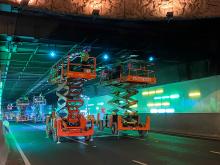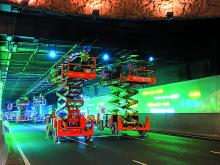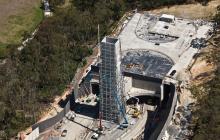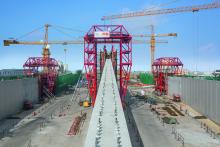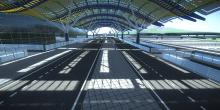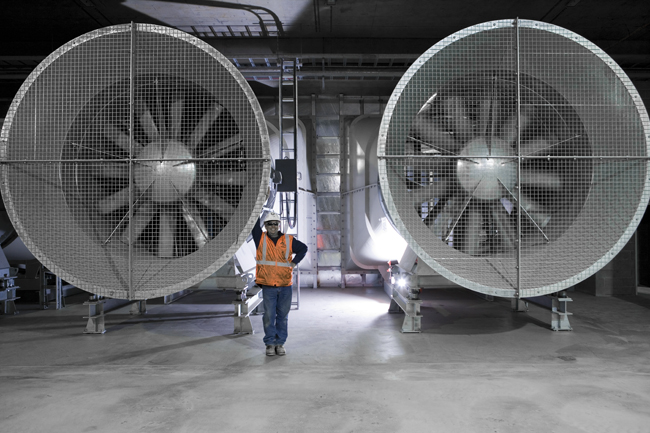
The Freeway Tunnel Ventilation On-Demand System for Melbourne’s EastLink project picked up the top Industry Award category at the recent 9th
Traditional tunnel ventilation systems are inefficient. Fans operate at fixed speed in manual mode or with individual fans programmed to switch on and off at preset times to ensure zero portal emissions with all emissions dispersed via ventilation stacks.
EastLink’s new ventilation on demand – VoD - system matches variable speed fan drives with more efficient impellers which are dynamically controlled based on real-time data from tunnel gas/airflow sensors.
The system reduced power by 68% and halved audible noise for local residents, as Doug Spencer-Roy, EastLink spokesperson, explains. “This award will help encourage Australia’s other freeway tunnel operators to implement ventilation on demand and replicate our success.”
Since EastLink opened in 2008 (see box), traditional methods have been used to manage tunnel ventilation. The original tunnel ventilation system was designed to expel all tunnel air, including all pollutants from vehicle engines via two 45m-high ventilation stacks.
Twelve smaller jet fans within each tunnel maintained airflow in through each tunnel portal, along the length of each tunnel, towards the base of each ventilation stack. Each stack has five large 275kW, 660VAC ventilation fans to draw air up from the tunnels for dissipation at the stack top, well away from local properties.
The speed of airflows within the tunnels and stacks was controlled by switching individual fans on and off. When switched on, a fan always operated at full speed.
Higher volumes of traffic required higher airflows and therefore more operating fans to dissipate vehicle pollutants via the stacks.
This on/off switching of fans was controlled by EastLink’s tunnel operating system using a simple preset programme based on time-of-day parameters. The largest number of fans operate during peak periods when vehicle pollutants are expected to be at their highest levels.
Variable speed drives
To allow fans to run at lower speeds, EastLink upgraded the 10 large ventilation fans from fixed speed fully off/fully on operation by installing variable speed drives to regulate the rotational speed of the impellers.
EastLink contracted
“Each ventilation fan, weighing over 7 tonnes, was separately removed from the tunnel complex,” says Spencer-Roy. “They were upgraded off-site, and reinstalled within the tunnel complex in delicate operations conducted during nights when traffic was lowest. Remarkably, tunnel closures were not required for these works. Traffic management was limited to temporary lane closures while at least one lane remained operating.”
To allow individual fans to be activated and fan speeds to be adjusted based on actual ventilation needs, EastLink developed a fully automatic ventilation control system. This enabled much more efficient self-regulating, or closed-loop, variable speed fan operation based on real-time data from existing air quality and airflow sensors.
EastLink tollway
The 40km EastLink – a tolled section of the M3 freeway - is the largest privately operated freeway network in the state of Victoria and the major north-south transport artery in Melbourne, the rapidly growing state capital. It includes twin 1.6km tunnels, carrying up to 115,000 vehicles per day via three traffic lanes in each tunnel. EastLink handles in total 250,000 vehicles daily and connects the Eastern, Monash, Frankston and Peninsula Link freeways. Being 53m underground means that the tunnels protect the environmentally sensitive Mullum Mullum valley above.Schneider Electric’s EcoStruxure platform was used to bring together automation, connectivity and software for real-time control and visibility. The top layer of the EcoStruxure solution is a SCADA control system. This provides an interface for EastLink engineers to see how the ventilation system is running at any time and from any location, including the EastLink control room.
Two pairs of Hot Standby Schneider Electric M580 ePAC - ethernet Programmable Automation Controller - were installed, one pair in each tunnel to create the closed-loop system to control the variable speed drive of each ventilation fan. The ePACs use real-time data from air quality and airflow sensors to dynamically control the speed and number of ventilation and jet fans required to meet ventilation needs.
“EastLink’s tunnel ventilation system now responds automatically and in real time to the volume of traffic travelling through the tunnels, the vehicle mix for example, the proportion of heavy vehicles, low and zero emission vehicles, and prevailing weather conditions,” says Spencer-Roy.
Emergency operation procedures were programmed into the system. If a vehicle fire occurs within the tunnel, the variable speed drives are automatically bypassed and all available fans operate at full speed. This ensures that tunnel evacuation proceeds safely.
Limited portal emissions
These improvements to the operating efficiency of the tunnel ventilation system and introduction of the closed-loop system to automatically activate fans and adjust fan speeds have enabled a change to EastLink’s tunnel ventilation system licence which has been agreed with the Environment Protection Authority Victoria.
This further increases the efficiency of the tunnel ventilation system: less air dissipated via the stacks means less use of ventilation fans.
EastLink also has air quality sensors located within the tunnels and within the ventilation stacks. These sensors measure carbon monoxide, various oxides of nitrogen and particulate matter. Airflow is measured at the tunnel portals and within the ventilation stacks. Daily air quality charts and quarterly reports are published on the EastLink website.
“To ensure that air quality standards in the local community have not been compromised through the introduction of these changes, we have supplemented the air quality sensors already located within the tunnels and stacks with a temporary air quality monitoring station located in a nearby residential area, close to one of the tunnel portals.”
Spencer-Roy notes that results of operating the new ventilation on demand system have exceeded EastLink’s expectations. Apart from energy cost savings, the reduction in consumption also reduced greenhouse gas emissions from power stations by an estimated 9,000tonnes annually.
Wear and tear on components has significantly reduced, which EastLink expects will reduce maintenance requirements and extend the life of components.
GRESB “5-star” sustainability rating
The internationally recognised GRESB Infrastructure Assessment covers the environmental, social and governance (ESG) performance of 280 infrastructure projects around the world. GRESB emerged from a collaboration of the world’s largest pension funds and academics from Maastricht University in the Netherlands and the University of California at Berkeley in the US. The inaugural GRESB Assessment in 2009 helped define ESG concepts and frameworks.
EastLink’s ventilation on demand system was a key factor in the 2018 GRESB Infrastructure Assessment awarding EastLink the top "5 star" sustainability rating for the third year in a row. In addition, the 2018 GRESB Infrastructure Assessment ranked EastLink as number one globally in the road companies (private entity) category and number five globally of 280 infrastructure projects

